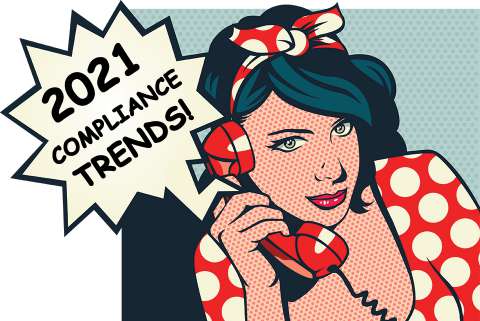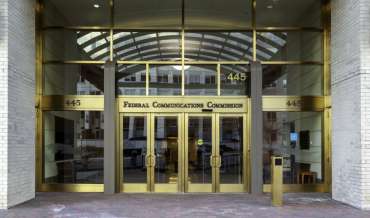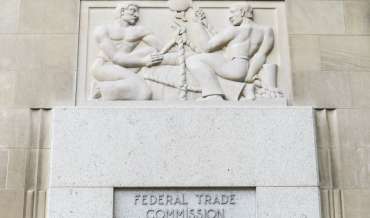There’s been a trend in outbound sales and lead generation over the last few years. You might describe it as a gradually constricting strangle on the ability of outbound call centers to actually get through to consumers.
It’s no secret that this trend runs a parallel course with the trends of increasing TCPA compliance restrictions and other FCC led efforts to shield consumers from telemarketing abuse.
In this post:
- Best ways to manage TCPA compliance risk in 2021
- Key points you need to know about STIR/SHAKEN
- Questions you should ask your dialer software provider about STIR/SHAKEN
- Does STIR/SHAKEN affect call blocking?
- How are virtual call centers affected by compliance?
- The silver lining of stricter telemarketing compliance
- Staying competitive in 2021 by adapting to TCPA compliance trends
In 2021, call center success requires understanding TCPA compliance trends and knowing what critical actions to take. One example, scheduled to go into effect in July 2021, is STIR/SHAKEN, the call authentication network intended to limit robocalls and caller ID spoofing – we’ll discuss the implications below.
Maintaining compliance protects companies from costly lawsuits and fines. As the FCC works to protect citizens from robocalling and spam calls, legitimate companies have to find ways to connect with prospects and customers without violating regulations, while using strategies that make sure calls get through to their leads.
Concerns with Blocked Calls and Flagging
Even when call centers operate in compliance with TCPA, they still confront issues with blocked and/or flagged calls. When DIDs get marked as spam, call centers end up spending a lot of money on leads, impacting the efficiency and profitability of their operation. That’s why we’ll cover this topic in more depth in a separate article.
In our 2020 polls of webinar attendees, outbound call center managers cited one of their biggest issues as low contact rates. And while there are a number of factors that contribute to low contact rates, there’s a definite connection between fewer conversations for your agents on the one hand, and blocked calls, spam-flagged DIDs, and the impact of TCPA rulings on the other.
In this article on TCPA compliance trends in 2021, we’ll take you through the compliance knowledge and solutions that are essential for every call center to stay competitive.
Check out our full summary list of 7 Outbound Call Center Trends to Stay Competitive in 2021
Best ways to manage TCPA compliance risk in 2021
Now in its 30th year, the Telephone Consumer Protection Act (TCPA) has long-reaching influence to protect consumers by regulating telemarketing calls, auto-dialed calls, pre-recorded calls, and text messages.
Regulations and procedures continue to serve this mission and the consequences for non-compliance are increasingly severe.
In our interview about 2021 call center trends with industry expert John Gallagher, CEO of Thrive Marketing LLC, he noted, “When you look at the TCPA and the change from a $1,500 per occurrence violation fee to $10,000, that’s going to be an enormous shift…One of the biggest risks to a call center is a class action TCPA case.”
Successful call center managers have TCPA compliance top of mind. Here are three of the best ways to manage compliance risks for your company.
1. Dialer that Supports TCPA Compliance
When it comes to TCPA compliance solutions for outbound call centers, your software platform is your greatest asset. To stay competitive in 2021, you need a dialer that supports TCPA compliance while optimizing every area of your operations.
Your contact center software provider should diligently stay abreast of updates and trends in TCPA regulations to minimize risk to customers. The dialer system should enable responsible dialing strategies (see #3 below). Depending on the type of leads you are calling and the consent associated with those leads, you may want to consider a manual dialing solution, like Convoso’s Click-to-Comply™ product.
Learn about monitoring agents for compliance with great QA – especially AI-driven QA – in our related blog post “QA for Outbound Call Centers: 2021 Trends for Lead Generation and Sales“
2. TCPA Compliant Leads
John Gallagher recommends that you buy TCPA compliant leads (and that’s where his consulting company, Thrive Marketing can be helpful). “You have to make sure that your opt-ins are legal. And while somebody may have an opt-in, getting an opt-in that will protect you is very much an art and a science. And then beyond that, there are systems that will help you make sure that nothing falls through the cracks. So systems like DNC.com, Anura, using TrustedForm and similar tools. These are some of the technologies that really make a difference.
“So, integrating those into your dialing system is critical for long term success. You might be able to do things on a short term basis and get away with it, but if you’re not implementing tools such as these, eventually somebody’s going to get to you. And for most of us, we’re in long term businesses and so you need to find a way to build these systems, talk to experts who have done it in the past and get it integrated.”
In the LeadsCouncil webinar “The 2.0 Call Center,” Executive Director Rob Seaver talked about the importance of getting submission forms right. “There are people who you get on the phone and you hear that dreaded, ‘I did not sign up,’ which is impacting TCPA, because if they did not fill out the form, or if they were not the owner of the phone number that they submitted the form with, you possibly could be looking at a TCPA violation.”
Learn Outbound Calling Strategies that accelerate lead efficiency and drive profitability
3. Responsible Dialing Strategies
Analyze Dialing Metrics
John Gallagher advises looking at how often you dial, and turning to the KPIs that will support compliance by analyzing dialing metrics.
“How many times do you call that number? You have a lot of people on your dialers, a lot of agents who are working on it and you have to make a choice whether you’re dialing one time a day, two times a day, three times a day. I know people push those numbers beyond that [but] you’re taking a risk and you have to do some real risk/reward analysis on it and look at your cost benefit.
“And to do that, you need metrics, you need KPIs, and you need to have somebody who’s really analyzing what is happening in your dialers, what are the returns on it, and what are the associated costs, because you’re not going to see those costs for a period above weeks or months after you make those dials.
“So when we start talking about these types of issues, you also have the opportunity to use the click-to-dial features and that can be an enormous shift in what your legal liability is…This is a very subjective process when you go through your analysis of how do you dial effectively, how do you protect yourself from lawsuits, what is an acceptable cost to the benefit? And it’s a comprehensive analysis.”
Learn the 16 Essential KPIs used by successful outbound and lead gen call centers to boost ROI
Smart Dialing Strategies and Caller ID Reputation Management
“Over-dialing your leads is the biggest problem,” shared Nima Hakimi, Convoso CEO & Co-Founder, in a webinar on STIR/SHAKEN and call blocking. “Your contact rates will just go down. It’s a failing strategy. We really want to make sure everybody truly understands it will no longer work.
“Instead, consider assigning a specific number of caller IDs per agent or adjusting your call cadence. Keep a flexible strategy that allows you to logically adjust to changes and maintain your contact rates.
“We know that in a perfect world, everybody would respond right away, but that doesn’t happen. So you need to have a system in place that can automate that lead follow-up process in a manner that doesn’t abuse the consumer and call them to death. [Then], you won’t be in the position where you’re over-dialing and your calls get blocked.”
In 2021 and beyond, it’s increasingly essential to avoid call blocking and DID flagging. Make sure your dialer supports smart dialing strategies and offers tools to manage your caller ID reputation. Convoso customer Jesse Daniels, VP Sales at One Health Direct, describes this as one of the biggest issues for large outbound call centers:
“We’re making a million outbound calls a day. I read a statistic lately that there’s about a 6% chance that someone’s going to pick up the phone if they see “Spam likely”. So if that’s showing up on their cell phones, they are not picking up the phones. And if people are not picking up the phones, I can’t make money and I can’t keep my business afloat. And I can’t keep the 500 employees that we have nationwide employed. So that’s huge.”
What is STIR/SHAKEN and why does it matter in 2021?
If you’re in the business of lead generation and outbound dialing in 2021, you need to understand STIR/SHAKEN.
Between 3 and 5 billion robocalls are made each month, and research suggests that more than 40% of those calls are thought to be fraud-related. The objective of STIR/SHAKEN is to combat malicious robocalling by having a system to authenticate calls.
STIR/SHAKEN is an industry-wide initiative to restore trust in voice communications. Its goal is to prevent fraudsters from scamming consumers and businesses through robocalls and illegal phone number spoofing, while making sure that legitimate calls reach the recipient. Telecom carriers are mandated to implement STIR/SHAKEN by June 2021.
Key points you need to know about STIR/SHAKEN
- STIR/SHAKEN stands for Secure Telephone Identity Revisited and Signature-based Handling of Asserted Information Using toKENs.
- How STIR/SHAKEN works: After July 2021, every call will be ‘signed’ by the call’s carrier, such as AT&T and Verizon. There will be different ratings, or attestations, of calls: A, B or C. These ratings allow carriers to verify information about the call, giving consumers a better idea of the validity of the caller. Over time the weight given to attestation ratings is expected to increase.
- The three attestation levels for rating calls – “A” rated calls are likely to be treated favorably, “B” and “C” suspiciously:
- A rating – the highest attestation level, means that the carrier is fully confident in the identity of the caller and their right to use that specific number and caller ID.
- B rating – the carrier knows who is making the call, but they aren’t sure if the caller is allowed to use that number or caller ID.
- C rating – a gateway attestation, means that the carrier can’t validate the caller’s identity or right to use the number/ caller ID.
- What will STIR/SHAKEN do?
- Show the level of confidence the originating carrier has in knowing who is making the call.
- Show if the caller has the authority and ability to use the caller ID information associated with the call.
- Why should your call center care? While STIR/SHAKEN is not specifically a compliance regulation for call centers, the consequences of industry implementation are not to be ignored. It could sink the unprepared outbound call center operation.
“If your carrier and platform isn’t STIR/SHAKEN [compliant by the deadline], you’ve got a problem.” –Stuart Discount, CEO of SMD Contact Center Consulting and former CEO of PACE. (PACE is the Professional Association for Customer Engagement, the largest non-profit trade association dedicated to contact center professionals)
Questions you should ask your dialer software provider about STIR/SHAKEN:
- What is your dialer company doing to prepare for STIR/SHAKEN?
- What is the highest attestation rating will they be able to provide?
- Are they signing calls themselves or are they going through a 3rd party to sign the calls? (if the latter, a B rating is the highest possible attestation they can provide)
- What is their timeline?
WARNING ABOUT OPEN SOURCE OR SELF-HOSTED DIALERS (e.g., VICIdial): Your call center will be at risk because these dialers will not be able to get an A rating.
How is Convoso preparing for STIR/SHAKEN?
Convoso has developed functionality to accommodate STIR/SHAKEN and the ability to sign calls. By the July 31 2021 deadline, Convoso will have the ability to sign an A-level attestation as appropriate for our customers.
As the #1 dialer for sales and lead generation teams, Convoso is required to go through due diligence procedures to make sure customers are who they say they are.
Does STIR/SHAKEN affect call blocking?
Call blocking is a huge issue for sales and lead generation call centers, and will continue to be in 2021.
While STIR/SHAKEN won’t actually block poorly rated calls, it will give consumers enough information to decide if they want to take the call. The new attestation ratings that will go into effect In July 2021 will impact blocking/flagging decisions by the carriers.
Some carriers already block calls they suspect are spam. They take into account hundreds of variables as input for blocking algorithms, including complaints, calling patterns, and call durations. If it meets their criteria, they block the calls made by that number or label them as spam.
Helpful Resources to learn more about STIR/SHAKEN
- STIR/SHAKEN & Call Blocking Webinar Recap and Video
- What Call Centers need to know about STIR/SHAKEN – Legal compliance expert guest post by Michele Shuster, Co-Founder of Mac Murray & Shuster LLP
- STIR/SHAKEN & Call Blocking – What lead gen call centers need to know Webinar Recap and Video
How are virtual call centers affected by compliance?
For many companies, Stuart Discount thinks the virtual call center is here to stay. “I don’t think the home agent model now is just a disaster relief solution. I actually believe some companies are going to go to this model as part of their normal contact center process.”
Many regulations were relaxed when agents were forced to work from home in 2020, but you should expect that to change.
Moving forward, keep an eye out for new regulatory requirements for at-home agents, possibilities of fraud, and solutions to PCI security with remote work. Especially if your call center handles payment card industry (PCI) data, you need to stay aware of the remote contact center discussion in 2021.
Assessing risk for your virtual operation and WFH employees
Start by asking risk assessment questions such as:
- Do we need to collect all of the information we are currently collecting?
- Can we limit some information to in-house agents?
Compliance legal expert and Founding Partner of Mac Murray & Shuster LLP, Michele Shuster encourages companies to consider the type of compliance risks they’re taking. In our WFH webinar Legal Aspects of Running a Virtual Outbound Call Center, Shuster suggested you ask some of these evaluation questions: “Is it that we’d be violating the law? Is it that if we had some type of privacy breach that it would be a damage to our reputation? Are we concerned about identity theft? Is it trade secrets? You have to analyze. As you’re doing this risk assessment, you’ll want to document the conclusions that you’ve come up with.”
Get the essential WFH guide Managing a Profitable and Compliant Virtual Call Center
Using your voice to influence legislation
Stuart Discount also urges call centers, particularly those in outbound, to start reaching out to Congress and influencing regulation. Many decisions that affect this industry are made by uninformed parties, so they can be more damaging or less effective than intended. Better call center regulations starts with making your voice heard, he said, and partnering with organizations that are working within the government to make these changes happen.
The silver lining of stricter telemarketing compliance
With stricter regulations and more serious consequences for ignoring compliance trends, 2021 will be a proving ground for businesses in the outbound dialing and telemarketing industry.
While no one wants to be fined or hit with lawsuits, more targeted regulations against telemarketing abuse results in a better playing field for the lead generation companies that play by the rules. The greater impact is, ironically, one of building trust with the public.
While there are no fines associated with the implementation of STIR/SHAKEN, there will be a natural attrition for those call centers and call center software providers that don’t take action.
Why Caller ID Authentication is a Good Thing
In the webinar “The 2.0 Call Center” Nima Hakimi, CEO & Co-Founder of Convoso, talked about the upsides of STIR/SHAKEN. “In the big picture, caller ID authentication is actually a good thing. Because the bad actors are the ones that are typically spoofing the caller IDs and using caller ID’s that are not valid. So you cannot get back to them. My prediction is once that it goes into place, call volumes will go down considerably, and the businesses that are doing it legitimately will thrive.”
Call Centers can see Higher Contact Rates
Stuart Discount advised that when your calls are verified, you can get more contacts per hour because consumers will see that your calls are legitimate. You should also work to keep relationships open with consumers who have given their consent to be contacted. This will keep you from getting into trouble for calling “verified” leads who haven’t given consent to your specific company.
Staying competitive in 2021 by adapting to TCPA compliance trends
The lead generation and telemarketing industries have to adapt. For outbound call centers, understanding and adapting to 2021 Compliance Trends means finding strategies to avoid call blocking, ensuring consent for calls and texts, and choosing a dialer provider that can sign A-level attestations for STIR/SHAKEN and support call center TCPA compliance.
In 2021, the companies that will survive and thrive will be working with TCPA compliant leads, smart dialing strategies, valid caller IDs, and using third party verified consent-based leads to contact targeted, qualified consumers. What better prospect to have than one who wants what you’re selling!





